The students of the 2015 NFLC cohort compiled two great videos of their experiences.
One includes highlights from the full semester. The other features the field research experiences they shared with members of communities in the Nilgiris.
The students of the 2015 NFLC cohort compiled two great videos of their experiences.
One includes highlights from the full semester. The other features the field research experiences they shared with members of communities in the Nilgiris.
Cole Norgaarden reflected on his spring 2015 experience at the NFLC. Check out the NFLC student-run Facebook page, where Cole describes a shift in his mindset about the purpose of his time in India, and how the work he was doing took on new meaning as a result.
From Meghan Furton
Seven weeks of class time gave us a valuable introduction to the Nilgiris Biosphere Reserve—to the natural environment, the interactions with the world outside, and the people living within—and created bonds of friendship between the 12 NFLC students. But now, we’ve followed the carefully laid-out curriculum as far as it will go. The faculty-paved trail ended and the wilderness began: it is up to us to use all that we had learned in the classroom and from each other to forge our own trails through 5 different research projects.
We are also splitting up—this is our first week apart. My concept of “we” has diminished to 3: Eshwari, our translator Durai, and I are the team assigned to work on water and waste in the Nilgiris. Here is a glimpse at our experience in the field…
We are staying in a room above the Keystone office in Coonoor. On our first full day in the field, Eshwari and I woke up early to work on field note documentation from the day before. After walking into Coonoor for a breakfast of Pongal and Pouri, we met our translator and caught one of the Kelly green, short-range buses to our destination village of Pajherthottam. By 11:30 am, we were surrounded by a group of young boys and our first volunteers. As we began conversations in one household, asking about drinking water sources, seasonal shortages, and waste and toilet habits, curious neighbors would pop their heads in and become our next volunteers. As we blazed through 4 conversations and an experimental mapping activity, we build up a reputation in the habitation and practice the difficulty of translating between English and Tamil. While I’m able to ask questions during the conversation, I’m completely lost during the introduction at the beginning. Multilingual conversations are still a huge challenge.
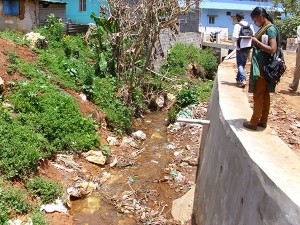
This stream bed running through town is filled with trash from a recent rainstorm and pipes discharging waste water without treatment. Contamination ignores city limits, but with so many upstream pollution problems, I wonder, why should this community care about water quality downstream?
We took a late lunch break in Coonoor for biryani and omelets, then returned to the village to speak to a woman who runs self-help groups and has applied for an individual toilet from a government aid program. This particular conversation is one example of the important relationships we are forming in the community: she is introducing us to the community structures and providing an interesting, proactive perspective to some of the concerns facing the village. By 6 pm, after many tea breaks, we were done with our guided conversations for the day and ready to head back into Coonoor and debrief all that we had learned—most important from the day was the difference between the houses on two opposite sides of the road. How do toilets, dumpsters, and water sources relate to the happiness and health of the people?
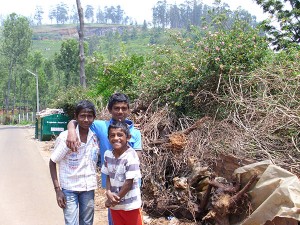
This group of boys lives in the first household we visited during the day. Behind them are piles of biowaste stacked by a panchayat dumpster that has not been emptied in the 2 months since its installation. Unfortunately, waste is littered all around the overfull dumpster as if it is not there at all.
Though much of the day was spent waiting for buses and waving to cackling hordes of children as I practiced my sloppy Tamil on them, our group had learned a lot just by being in the village—this kind of learning through participation, outside of formal “interviews,”’ is the ethnography part of our research project. Though the water and waste questions are somewhat straightforward, it is important to balance a deep understanding of the community with an easy-to-compare list of quantitative data points
But this is just part one of 5… Next week, we will all return from the field, ready to share our experiences from our individual projects. Stay tuned as the NFLC launches itself into uncharted territory: research.
From Hope Craig
It’s hard to believe that nine weeks have passed since we stumbled, wide-eyed and eager, onto the Keystone campus in January. Looking back on our first week in Kotagiri, I can’t help but smile thinking of the awe and curiosity with which we readily soaked in the beauty of the Nilgiris hills, the warmth of the Keystone community, and every inkling of newness that Kotagiri offered. There were many novelties, and there still are!
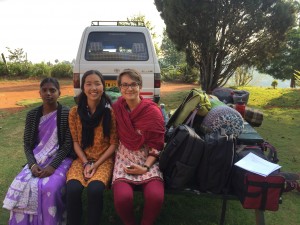 Nonetheless, it’s amazing to me how much has changed since our first day: how familiar we are with the area, how closely we have connected with one another, and how comfortable we have become with the routine unpredictability of each day. Though we have become so accustomed to our lives in Kotagiri, there are many questions and uncertainties that remain for the weeks ahead.
Nonetheless, it’s amazing to me how much has changed since our first day: how familiar we are with the area, how closely we have connected with one another, and how comfortable we have become with the routine unpredictability of each day. Though we have become so accustomed to our lives in Kotagiri, there are many questions and uncertainties that remain for the weeks ahead.
Among the many things this week has shown us, what strikes me most is the value of the naivety that remains a leading influence on our outlook and perspective. This was a leading message of Becky’s lectures this week. Though the complex and nuanced nature of the NBR continues to deepen or, as we would joke in class, our onion develops more layers of meaning, the curiosity and interest of our naivety provide a method of sharing knowledge and experiences. Seemingly endless, our questions stream during interviews and class discussions as we determinedly try to understand the thick description surrounding us. I’m eager to embrace our coming weeks of fieldwork to perhaps better understand the many webs of meanings that layer our research topics.
 With Becky, Jess, Andrew, Archana, Pratim, and Bala all here with us this week, it’s safe to say our classroom has been a powerhouse as we prepare to embrace the thick description of our research projects. Ranging from topics in infant feeding and dietary diversity to the Forest Rights Act or waste management, our fieldwork covers a variety of perspectives and concentrations in the Nilgiris Biosphere Reserve. We began the week with momentum as we voiced our research goals, reviewed informed consent processes, and discussed research sites and household surveys for the weeks to come. Until this week, I had considered our naivety to be a drawback. After our field site visit to Gethaikadu earlier this week, however, I found that naivety and curiosity allowed me and my classmates to try to understand the deeper meaning underlying what we saw, heard, and felt. As we embark on part two of the semester, the novelty of our experiences has largely been renewed as we prepare for fieldwork.
With Becky, Jess, Andrew, Archana, Pratim, and Bala all here with us this week, it’s safe to say our classroom has been a powerhouse as we prepare to embrace the thick description of our research projects. Ranging from topics in infant feeding and dietary diversity to the Forest Rights Act or waste management, our fieldwork covers a variety of perspectives and concentrations in the Nilgiris Biosphere Reserve. We began the week with momentum as we voiced our research goals, reviewed informed consent processes, and discussed research sites and household surveys for the weeks to come. Until this week, I had considered our naivety to be a drawback. After our field site visit to Gethaikadu earlier this week, however, I found that naivety and curiosity allowed me and my classmates to try to understand the deeper meaning underlying what we saw, heard, and felt. As we embark on part two of the semester, the novelty of our experiences has largely been renewed as we prepare for fieldwork.
As we cope with the uncertainty and novelty of the weeks to come, I am comforted by the tangible passion I share with my classmates and teachers, and I am eager to continue to ‘peel the onion’ together.
From Hanna Reichel
It rained yesterday, for the first time in our nearly two months here in Kotagiri. We watched the clouds gather over the tea fields, casting the Blue Hills with an eerie orange glow. Wayward breezes blew a cool up the valley, and scattered the brilliant purple blooms of the jacaranda. A calm settled over the landscape, silencing the regular symphony of honking cars. Raindrops began to pick a beat on the roof of Mandarae and then, suddenly, the atmosphere was saturated with water.
Nothing compares to the first rain of the season, but it seemed particularly auspicious timing, as we wrap up our seventh week of class at the NFLC.
These last few lectures mark the end of our classroom experience. After a short vacation that will take us across Tamil Nadu to the coast of the Indian Ocean, we’ll return to Kotagiri and begin our research in earnest, working extensively in the field and intensively on analysis. Indeed, I’ve heard the same sentiment echoed by all of us in recent weeks: disbelief that nearly two months have passed, already, and uncertainty as to whether we’ll be ready for what lies ahead.
To the question of time, I say that surely seven weeks is a long while, but it’s not as if a moment has been wasted, either. We’ve covered impressive ground, an imperative in a context so exotic and complex as the Nilgiris Biosphere Reserve. Our first week established methods of inquiry and analysis, so that we could be better observers and thinkers in this new environment. We then spent an entire week exploring the conceptual and functional meaning of a Biosphere Reserve, and another trying to comprehend the vast yet intricate system of Indian governance.
Two units were devoted to interpreting the unique sociocultural context of the Nilgiris, and grasping the role of the spiritual and psychological in shaping wellbeing of communities and nature. In the last two weeks, we’ve discussed in-depth the history and prognosis of Nilgiris livelihoods, and examined means of supporting these through enterprise initiatives.
To complement these units, we’ve had many field visits, frequent guest lectures, and countless debriefs. As others have mentioned in their blog posts, this process of thinking, imagining, and experiencing has helped us to establish strong bonds with one another, and been so powerful that we’ve occasionally forgotten that we’re in India – we’re simply here.
This sort of in situ attitude is perhaps our greatest asset as NFLC students. It shows that we’ve taken root in the Kotagiri context – but true to biology, there is hardly anything static about being rooted; rather, there is the opportunity for growth. This dynamic habit is the antidote to our qualms about uncertainty: in the last seven weeks, we’ve repeatedly overcome our doubts by embracing them, and immersing ourselves in this environment.
We’re concluding now with a mini-unit on urbanization, which ties together much of our collective thinking – on the relationship between humans and nature; the promises (and perils) of development; and the necessity to consider community when addressing sustainability. The NFLC, and the greater Nilgiris context, provides fertile ground for exploring these momentous topics, yet the questions we’re asking have emerged organically.
As yesterday’s rains dissipated, they left behind a brilliant scene – revealing the world anew, cleaned of its layer of insidious dust. The leaves and blossoms of March shone, verdant and hopeful, and the cool air bore the unmistakable scent of promise. In that moment, all feelings of disbelief and uncertainty evaporated, overcome by that innate and insatiable impulse we’ve become so accustomed to thriving on: the unquenchable desire to learn.
From Laura Powis
The beauty of staying in a foreign place for such a long time is that, to some degree, you begin to become immune to its natural beauty. Walking through the breathtaking hills of Kotagiri is becoming such a normal part of my daily routine that I find myself almost not noticing that they are there. Almost every morning before breakfast, a group of us NFLCers don our yoga pants and running shows to embark upon speedy walks around the Keystone hill.
On today’s morning walk, Hope remarked that as of late, she spends more time looking at her feet than actually paying attention to the scenery. I realized that she was not alone in this practice, as I also have been spending more time examining the roads for surprise cow pies than admiring my surroundings. While it is alarming to realize that I am not always actively appreciating the beauty and quirks of this, I now understand that becoming so comfortable here has allowed me to look past the flashy features of India to really get to know the people who live here.
My time in India has made me realize that you don’t necessarily need to speak the same language as someone to develop a genuine connection with them. We Cornellians have found that over the past weeks, our relationships with the community member students have become incredibly rich. Spending almost all day, every day together, we have developed our own form of language consisting of broken English/Tamil, meaningful looks, and accentuated hand gestures through which we can communicate things that we probably couldn’t find words for if we spoke the same language. Numerous inside jokes have developed amongst our group and mealtimes are filled with laughter and smiles. As the strength of our NFLC community grows, I find that I no longer see as much of a distinction between the Cornell students and the community member students; we are an eclectic, passionate group of individuals who have come together to form our own unique family.
I think that living together has greatly facilitated the formation of our NFLC family. The dining room at Highfields (our hostel) has been the central location for our group banter. From debating the appropriate spiciness of the food we are served to teaching each other cultural dances (our cultural dance being the Macarena) to becoming each other’s hair stylists, the dining room at Highfields has become so much more than simply a place where we eat food—it is a place where we form personal bonds with people that transcend cultural divides.
When applying for the NFLC, I did not really know what to expect out of experience. I assumed that I would get to see beautiful places and learn incredible things, but for some reason I did not really think about the human aspect of the experience. Even if I had, I don’t think that I could have anticipated that I would form such intimate connections with the people in this program, both Keystone and Cornell alike. On that happy note, I look forward to the weeks ahead!
From Cole Norgaarden
It’s the end of Week 5 and the reality of our semi-permanent presence in this place—India, Keystone, Kotagiri, the Nilgiri Biosphere Reserve—is beginning to truly sink in. Weekly outings to the market (which we can now proudly navigate independently) have become full of familiar faces from campus, and the town, which initially seemed overwhelming despite its small size, now feels a little more like home. The speaking, eating, and clothing habits we brought from home have all morphed in one way or another to reflect the new environment around us, to the point where I find myself talking like a Tamil English-speaker to my American peers. Teatime, a previously alien concept, is now a crucial component of our daily routine. And as we continue to accumulate items from Keystone’s network of Green Shops, we would like to think that our visual appearance is slowly beginning to blend in as well. Thanks to the unending patience of our local counterparts, together we have been able to foster a genuine, if only personal, sense of belonging in the community where we are living. Lately, it’s become harder to remember that I have been in a foreign country for a full month and will be here for three more.
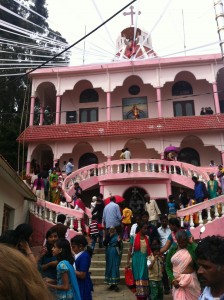 In fact, I’ve heard several people in our cohort remark at how they have forgotten that they are in India, or that at times it doesn’t feel like they are in India at all. I think this is an interesting thought to explore, considering that in some ways we couldn’t be more in India. Experiences like conversing with traditional healers, visiting villages deep in the hills, and living with six youth who have grown up within the local culture have already given us a much more intimate look at life in India than most outsiders would ever receive. At the same time I feel that these experiences may also be the reason that we are confronting some difficulty in reconciling our preconceived notions with our actual observations. Before arriving in India, the expectations of those of us coming from the US had been conditioned by the highly objectified version of Indian culture that appears in the media. Books like Katherine Boo’s Behind the Beautiful Forevers and Kiran Desai’s The Inheritance of Loss, plus popular films like Slumdog Millionaire have planted foundational ideas in our minds about what India is, or should be.
In fact, I’ve heard several people in our cohort remark at how they have forgotten that they are in India, or that at times it doesn’t feel like they are in India at all. I think this is an interesting thought to explore, considering that in some ways we couldn’t be more in India. Experiences like conversing with traditional healers, visiting villages deep in the hills, and living with six youth who have grown up within the local culture have already given us a much more intimate look at life in India than most outsiders would ever receive. At the same time I feel that these experiences may also be the reason that we are confronting some difficulty in reconciling our preconceived notions with our actual observations. Before arriving in India, the expectations of those of us coming from the US had been conditioned by the highly objectified version of Indian culture that appears in the media. Books like Katherine Boo’s Behind the Beautiful Forevers and Kiran Desai’s The Inheritance of Loss, plus popular films like Slumdog Millionaire have planted foundational ideas in our minds about what India is, or should be.
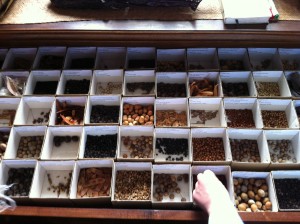 In some ways, I expected that coming here would simply be a deeper immersion in these same images. But staying in one place for a month has a way of upsetting stereotypes and producing a sort of hybrid reality. Witnessing the sheer diversity of people, and starting to recognize those I know from my own life in their faces, is just one example of the process of normalizing our experience that is under way. After five weeks, I now crave mushroom paneer or masala dosa much more often than food from home; encounters with the gaur, which were the subject of intense enthusiasm at the beginning, have become nonchalant. The objectified India in my head resurfaces every time a cow interrupts traffic or I start into another meal served on banana leaf, but these features have different meaning within the nuanced context we are attempting to piece together.
In some ways, I expected that coming here would simply be a deeper immersion in these same images. But staying in one place for a month has a way of upsetting stereotypes and producing a sort of hybrid reality. Witnessing the sheer diversity of people, and starting to recognize those I know from my own life in their faces, is just one example of the process of normalizing our experience that is under way. After five weeks, I now crave mushroom paneer or masala dosa much more often than food from home; encounters with the gaur, which were the subject of intense enthusiasm at the beginning, have become nonchalant. The objectified India in my head resurfaces every time a cow interrupts traffic or I start into another meal served on banana leaf, but these features have different meaning within the nuanced context we are attempting to piece together.
From Jocelyn Lee
This past week, things have started to click. In the beginning, we seemed to be creating a rough sketch of where we are, why we are here, and who we are in relation to our fellow community member students. This sketch has become more finely detailed as we have erased and redrawn lines, and then continued to revise as we see things in new light. However, over the past several days we have begun to fill in the lines with color (to continue the metaphor). The nuances and contradictions of the various distinct cultures surrounding us are slowly becoming more apparent, enriching our understanding of this region.
One of the concepts emphasized in class this week was “thick description” – the idea that any given cultural act or object is part of a complex web of meaning, where you cannot begin to understand something without exploring the context and underlying connotations. Often used half jokingly and half seriously by us in conversation, the term “thick description” perfectly encapsulates Week 4.
From a wedding that we attended to in-class activities, we learned just how much one can miss by failing to study an experience beyond its surface level. We are discovering “thick description” in our relationships with the community member students, as well. While in the beginning of the semester we were often challenged to think critically about our own lives and worldviews, we are now focusing more closely on the worldviews and webs of meaning that exist among the surrounding adivasi communities. When addressing these topics, it is imperative that we continue to remind ourselves of our own biases and perceptions of truth and to leave room for reimagining them.
The kinds of conversations that we are having with the community member students touch on matters of dignity, shame, feelings of inferiority, loss of culture, and personal responsibility and decisions. On Friday, we visited the Toda village of Kuttan, a Keystone staff member. He explained the gap in understanding between his people and the government regarding the land.This dialogue requires a new kind of sensitivity and self-awareness on our part that I think we are all becoming increasingly aware of. I am finding that with “thick description” of culture comes a sort of “thick” analysis of self and of what you do with the complexity of knowledge that you gain.
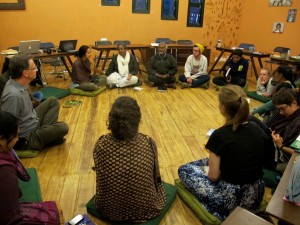
The NFLC team discusses changes in adivasi livelihoods and the implications of loss of traditional knowledge
Many of the days recently have ended with all students and teachers sitting on cushions in a circle on the floor, letting the conversation go where is natural (while still tying into class themes of the day). I so deeply appreciate that we can have these times of informal learning – there is enough structure that we have proper translations to facilitate the conversation, but there is also a certain “unstructuredness” that allows for sharing of thoughts and stories, without the pressure that a formal classroom sometimes imparts. It is during these discussions that I am challenged to think the hardest, be utterly confused and overwhelmed, yet also feel inspired and motivated.
From Samsuda Khem-nguad
NFLC continues to be a constant journey of exploration, but for the Cornell students, week three has also been a lot about settling in. Yes, it is now natural for us to eat spicy sambar with our (right) hand for breakfast, wiggle our heads side to side to indicate approval (instead of nods), and do laundry in buckets. But we have also discovered places around the Nilgiris that made use feel closer to home: the chocolate shops, bakeries, ice cream stand with soft-serves and red velvet cupcakes, and a small grocery store called “Modern” which sells peanut butter as well as cereals!
For the Keystone students, this place was already familiar, yet they have also discovered dimensions of the place that previously seemed unapproachable to the common men. As ‘Governance’ is the theme of the week, our class has been able to go meet different governing officials of the area; the Nilgiris District Collector, the Coimbatore Police Commissioner, and the Wayanad Forest Warden. We finished our trip to Coimbatore with a trip to a very large mall to see a Tamilian movie, and just going up the escalator was a new experience for many of the Keystone students.
At certain points, I felt a little disappointed that our group is here to celebrate indigenous knowledge and learn about the traditional wisdoms, yet we have been exposed to so much western influences this past week and I have thoroughly enjoyed it. Quite frankly, we cannot contain our excitement when we see ice cream stores, bakeries, and places with cheese sandwiches! But isn’t it this same globalization that is bringing all the familiar tastes to us, that has suppressed the traditional knowledge that we are here to appreciate? It makes me question of where the line is drawn between embracing this beautiful, culturally rich place, and care for the part of us that seeks the ‘comfort zone.’
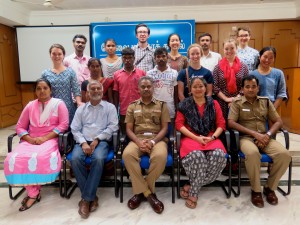
Our group photo with the Police Commissioner of Coimbatore City, who has been so kind to meet with us!
Having been in a small community for just over two weeks, I felt overloaded by all the new encounters. For the Keystone students who came from even tighter knit communities, this might have been the greatest influx of modernity and westernization into their lives. The experiences of being placed in front of so many authorities or just seeing a film with so much “glamor” as they call it here, can be fascinating, but at the same time perhaps is also unconsciously be-littling.
Even to my untrained eyes, with their petite builds and beautiful traditional clothing, our Adivasi friends presented a contrasted the rest of the westernized Indians in their shorts and t-shirts at the mall. I wish I could just blindfold them from all these temptations to change, and keep them in their villages where life is already beautiful (or so I romanticize). Yet I know that It would be unrealistic to turn a blind eye on all these new influences which are right on our door step, they are a crucial part of reality too.
I think learning how to place oneself appropriately in these situations with a critical mind is of utmost importance. How can we confront modernity without letting go of our roots and retain our dignity? As Cornell students what is our role with respect to our partner Adivasi students? What should be our role? I am conflicted whether I should get another scoop of ice cream on our next trip to Modern, or if that is just a roundabout way to show my support for globalization?
Is globalization even a bad thing – or just another natural phenomena that all communities must learn to co-exist with? I guess as I became more familiar with the place, I have certainly become more cynical as well. There remain no conclusions to these questions as we continue to explore, and yes, it is only week three.
From Meghan Furton
Wow! Kotagiri has to be the most colorful place in the world; from the lovely red earth and vivid green tea leaves lining the steep mountain sides, to the tightly packed pastel houses and shrines, to the lovely sparkling saris and even the less lovely but occasionally sparkling rubbish lining the roads—the whole place is a feast for the eyes. The other senses have not been neglected, either: The clean mountain air, the barking dogs and singing birds, and the delicious food all factor into our first impressions of our new classroom.
After two weeks, it is clear that I have a lot more learning to do than what is discussed in the nightly readings. Here is a glimpse of the normal routine here that was anything but normal to me: how bathrooms are used in Kotagiri.
BUCKET BATHS
Showers, I believe, are sacred things. A time to blissfully waste water in steamy comfort. If you have long hair (as I do) they even serve an important function. But at the Highfield hostel in Kotagiri, we use buckets instead of shower heads.
Here are the steps I follow in the morning to take a bucket bath:
LAUNDRY
Congratulations! Your hair and body are clean, and you’ve recovered from the surprising chill of being wet up in the mountains. But what about your clothes? Here is how we wash our clothes without the aid of machines and dryers:
A digression, for all of you skeptics out there: moving the water quickly through the pores in your clothes is how dirt particles are removed. There is no witchcraft going on in the machines, but that which can be recreated with hands. Imagine squeezing water out of a kitchen sponge to clean it: the high velocity of the water through the material causes shear forces on any particles stuck to the sponge, overcoming friction and transporting the particles away…
TOILETS
Okay, okay, hand washing clothes isn’t such a challenge. And who doesn’t love slipping into sun-warmed shirts and pants? But have you ever considered life without toilet paper? Yep, the plastic bucket and small scoop are back.
Besides toilet paper, I had always taken for granted the MEN and WOMEN symbols that denote restroom gender back home. But here, the familiar symbols are nowhere to be found. In this public bathroom on the road between Highfield and Keystone campus, the unfamiliar Tamilian script leaves me clueless:
On Keystone campus, the bathrooms are marked with male and female symbols:
These abstract images, where the woman is denoted by a bun in her hair, are a relatively recent phenomenon in India. The use of hair styles to differentiate gender makes me wonder about the triangular skirt we are so familiar with. What do buns and triangles have to do with women, really?
Both the beautiful script and interesting clay tablets shame our uniform stick people. This presents a toss-up between what is fun to look at and what is easy to understand—between what is creative and what is regulated. India proves that even going to the bathroom can be an artistic experience. Learning here, in general, comes from a much more organic, community-centered place than the institution of grades and standardized tests I am used to.
One last comment on bathrooms: the porcelain thrones themselves are different. I am learning the difference between the Indian and Western toilets, but this process is a little easier on us at Keystone… they have both!
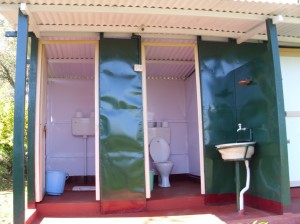
This magic bathroom stall has toilet paper (disposed of in out of site waste bins) and an incredible view of Kotagiri! The best of both worlds, in my opinion.
Even after such a short time at the NFLC, my content western eyes have been opened to an entirely new view on everyday life—the bathrooms are only a small part and only the beginning. I can’t wait to meet the person I have become after 16 weeks here!